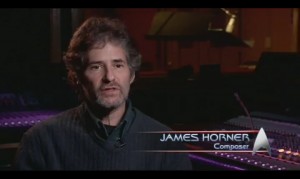
Image courtesy of Paramount Home Entertainment
I was recently discussing my feelings about composer James Horner with a friend on Facebook. If the name is unfamiliar to you, I guarantee that his music is familiar. He has scored films for over 30 years and won two Oscars® (both for his work on Titanic).
In addition to his accolades, Mr. Horner has also been accused of ripping off his own music. In some cases, small sections of his themes have been transplanted from one film straight into another. The thing of it is, however, I enjoy the works of Mr. Horner. And truth be told, many film composers “borrow” from themselves. Even the godfather of modern cinema sound, Mr. John Williams himself, has liberally taken bits and pieces from one score and incorporated them into others.
I have spent many years listening to Mr. Horner’s works and, while I am a fan of his, I do enjoy his earlier works best. They have a signature sound which may betray the relative youth of the composer at the time, but they are bombastic and frenetic enough to be among my favorite scores ever.
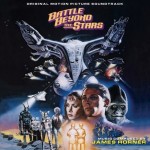
Soundtrack available from BSX Records
My introduction to the work of James Horner was 1980’s Battle Beyond The Stars. The film, which clearly tried to cash in on the Star Wars/Star Trek craze of the late ’70s, starred Robert Vaughn, George Peppard and Sybil Danning and was produced by Roger Corman. A decent enough B-movie and a product of its time, the film was unquestionably elevated by Horner’s main title theme. Small, haunting hints of horns followed by percussive beats give way to a grand statement of the hero theme, played loud and brassy, followed by a more thoughtful section of strings for the B theme. For a smaller picture such as this, the music seems almost out of place, grander than the images that accompany it.
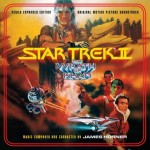
Soundtrack available from FilmScore Monthly
The next film that Mr. Horner scored left an indelible print on my imagination. It was 1982 and the crew of the Starship Enterprise was returning to the big screen in Star Trek II: The Wrath of Khan. Director Nicholas Meyer asked for a nautical approach to the score, which Horner clearly took to heart. In addition to the seafaring motifs played throughout the score, Mr. Horner also deftly merged in Alexander Courage’s theme from the original Star Trek TV series (something that Jerry Goldsmith had attempted to do in Star Trek: The Motion Picture, to slightly less effect).
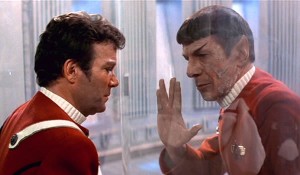 But Mr. Horner’s greatest triumph in the Khan score was his theme for Spock, which mixed strings with a synthesized sound that was both alien and very human. The theme plays throughout the film, and accentuates “The Death of Spock” to such chilling effect that the music becomes equally as important as the acting in that scene.
But Mr. Horner’s greatest triumph in the Khan score was his theme for Spock, which mixed strings with a synthesized sound that was both alien and very human. The theme plays throughout the film, and accentuates “The Death of Spock” to such chilling effect that the music becomes equally as important as the acting in that scene.
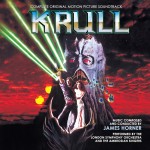
Soundtrack available from La La Land Records
The following year, Horner composed the score for the fantasy epic Krull. The main theme here begins with a chorus joining a building brass sound reminiscent of an old knight’s tale. Horner lets the trumpets fly as if calling us to a royal court. Then comes what I will now refer to as the “Horner Strings”. It’s a sound that Mr. Horner uses in many of his scores. While I’m not an expert in orchestral music per se, the closest I can describe is a series of three quick notes on strings played again and again. They seem to mostly serve for atmosphere, but they are prevalent in many of Mr. Horner’s scores.
Again, the music for Krull serves to elevate the film far beyond what it could have been without it. The effects were OK, the acting was reasonable. Close your eyes, listen to the score, and believe you’re watching a big budget fantasy tale of knights and monsters.
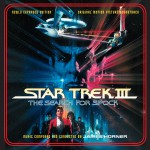
Soundtrack available from FilmScore Monthly
Being relatively young at the time, I wouldn’t get to hear Mr. Horner again until the following year’s Star Trek III: The Search for Spock. While the film did borrow heavily on the themes established in the first film, Mr. Horner did have some incredible room to expand. He created his own theme for the Klingons as well as the sweeping “Return to Vulcan”. To me, however, he contributed to one of the perfect moments in cinema with “Stealing the Enterprise”.
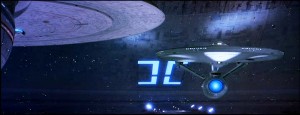 I realize I might lose half my audience if I don’t explain why this is a “perfect moment in cinema” and how it could possibly have come about in a Star Trek film. The answer is relatively simple. For me, a “perfect moment in cinema” comes when all aspects of the film come together and do their jobs perfectly. The “Stealing the Enterprise” sequence does that and more.
I realize I might lose half my audience if I don’t explain why this is a “perfect moment in cinema” and how it could possibly have come about in a Star Trek film. The answer is relatively simple. For me, a “perfect moment in cinema” comes when all aspects of the film come together and do their jobs perfectly. The “Stealing the Enterprise” sequence does that and more. 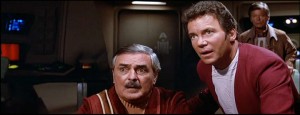 The dialogue for this scene is well-written and tight, laced with humor and drama. The acting is impeccable (from the rousing inspirational moment where the crew vow to help Kirk and McCoy, to Kirk and Scotty praying the ship doesn’t ram right into the space doors), the special effects go way beyond what was normal for the time (and are even impressive by today’s CG standards), and the music is flawless, conducting the action and drama. Everyone here did their jobs, hence the PMIC.
The dialogue for this scene is well-written and tight, laced with humor and drama. The acting is impeccable (from the rousing inspirational moment where the crew vow to help Kirk and McCoy, to Kirk and Scotty praying the ship doesn’t ram right into the space doors), the special effects go way beyond what was normal for the time (and are even impressive by today’s CG standards), and the music is flawless, conducting the action and drama. Everyone here did their jobs, hence the PMIC.
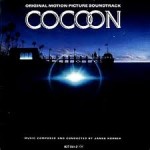
Soundtrack available from P.E.G.
In 1985, director Ron Howard gave us the story of senior citizens meeting visitors from another world in Cocoon. The film, which starred Wilford Brimley, Hume Cronyn, Jessica Tandy, Steve Guttenberg and Brian Dennehy, was also scored by James Horner. Horner’s end title music for the film stands as one of the most emotional pieces of work I feel he’s ever done. Like much of the score itself, it’s very bittersweet. Lush with strings, the theme takes you on a journey through peaceful pastures, and sorrowful goodbyes.
Cocoon, however, is also the scene of the first full-on “crime” in Horner’s collection. In the climactic “The Chase”, Horner borrows a section of music directly from Star Trek II: The Wrath of Khan. If you have both scores available, tracking down the bits in question is easy.
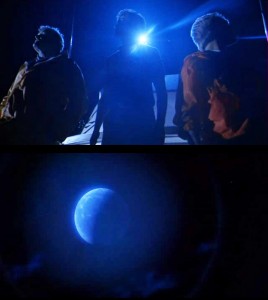 On Cocoon, find the track called “The Chase” and skip ahead to 2:05. If you only have the film, go to the scene where the boat is being chased by the coast guard. (This part of the music starts when Guttenberg’s character tells the aliens to signal their friends, and the music is heralded by a shot of the moon.) Listen for about :23.
On Cocoon, find the track called “The Chase” and skip ahead to 2:05. If you only have the film, go to the scene where the boat is being chased by the coast guard. (This part of the music starts when Guttenberg’s character tells the aliens to signal their friends, and the music is heralded by a shot of the moon.) Listen for about :23.
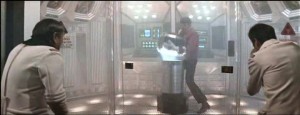 Then go to Star Trek II: The Wrath of Khan and find “Genesis Countdown”. Skip ahead to 2:20. (In the film, this part of the music happens when Spock is in the radiation chamber and is about to pull the lid off the mechanism inside). Listen for about the same amount of time. Basically, you’ve got a match, note-for-note.
Then go to Star Trek II: The Wrath of Khan and find “Genesis Countdown”. Skip ahead to 2:20. (In the film, this part of the music happens when Spock is in the radiation chamber and is about to pull the lid off the mechanism inside). Listen for about the same amount of time. Basically, you’ve got a match, note-for-note.
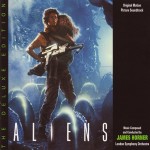
Soundtrack available from Varese Sarabande
In 1986, Horner did the score for James Cameron’s Aliens. A sequel to the original Ridley Scott film, this marks the second time that Horner does the music for a sequel to a film scored by Jerry Goldsmith. Here Mr. Horner expands on the military motifs he created for the Star Trek universe, this time bringing percussion in to serve as equals to the brass sound. Whereas Trek was about the navy and sailing ships, Aliens was the colonial marines and down-and-dirty warfare. The percussion and horns were accompanied by an occasional driving metal-clanking sound. The aliens themselves were accompanied by a sharp whine which almost served as a companion to the aliens’ own hissing sound. The two sounds, when brought together, caused many a theater-goer to jump out of their seats.
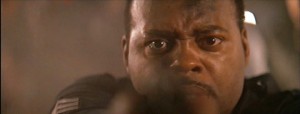 If there is a problem with the score to this film, it’s that the heroic theme bears a striking resemblance to the Klingon theme from Star Trek III: The Search for Spock, only sped up a tad. It’s interesting to note that there was a piece of music written for this film, “Resolution and Hyperspace” that wound up not used in this film at all, but was ultimately first heard at the very end Michael Kamen’s score for Die Hard, when Powell (Reginald Veljohnson) kills the last bad guy.
If there is a problem with the score to this film, it’s that the heroic theme bears a striking resemblance to the Klingon theme from Star Trek III: The Search for Spock, only sped up a tad. It’s interesting to note that there was a piece of music written for this film, “Resolution and Hyperspace” that wound up not used in this film at all, but was ultimately first heard at the very end Michael Kamen’s score for Die Hard, when Powell (Reginald Veljohnson) kills the last bad guy.
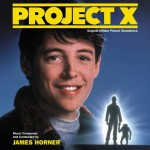
Soundtrack available from Varese Sarabande
In 1987, James Horner composed the score for Project X, starring Matthew Broderick and Helen Hunt. The score’s gentle nature seems slightly inspired by the same feel as Cocoon, only this time there is a flute added to great effect to signify the chimps and the jungle that they came from. The woodwind sound is played equally joyously and hauntingly throughout the film, punctuating the simplicity and wonder of the animals contrasted with the cruelty being perpetrated on them by the humans of the film.
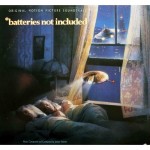
Soundtrack available from MCA
That same year, Mr. Horner was reunited with Hume Cronyn and Jessica Tandy for *batteries not included. In the film Cocoon, Horner had developed a big-band sound for the film’s older cast which he tweaks for this film. It makes the music as much of a participant in the film as the actors (almost as if he was scoring Tandy and Cronyn instead of their characters). The sound is wonderful to hear and therefore welcome in either film. What the film also shares with Cocoon is the very understated sound for the aliens in the film. Both films offer very sympathetic alien characters, and in this film there is a whole alien family involved. And much like how the characters of the film become a family of their own, the music softly whispers “family” in its tone and sound.
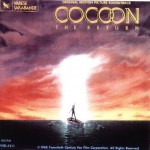
Soundtrack available from Universal International
The following year I saw Cocoon: The Return which was also scored by James Horner. Revisiting the themes from the original, the score was more-or-less on autopilot, but the themes from the first film play just as well here, so there is no loss. Horner’s music continues to serve the film well.
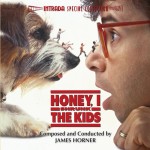
Soundtrack available from Intrada
1989 saw an incredible departure from the typical Horner sound in Honey, I Shrunk The Kids. Here, Horner instead embraces an almost Looney Tunes-esque comedy sound. An almost donkey-sounding brass whinny comes in from time to time to remind the audience that they’re in for a fun ride.
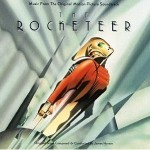
Soundtrack available from Hollywood Records
The next memorable score I heard from James Horner didn’t come until 1991’s The Rocketeer. Whether you liked the film or not (I did), there is an unmistakable charm to the score. It captures the child-like innocence that permeates the film despite its more adult themes. Horner not only captures the feel of the period piece, but he also kicks his brass into high-gear in the action sequences, creating an aural sound reminiscent of the action films of the 1940s. Again, if this score has any flaws they stem from its similarity to his Star Trek scores, especially toward the end of the end titles.
For me, however, this isn’t a problem. I like the sound. If it’s not lifted note-for-note (as was the 23-second case in Cocoon) I don’t find it distracting, I find it to be an almost musical shorthand for evoking feeling in an action sequence. As long as the music is doing its job, I won’t really complain.
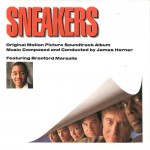
Soundtrack available from Columbia
In 1992 Robert Redford headlined an all-star cast in the ensemble thriller Sneakers. The story was a cloak-and-dagger espionage tale involving the world’s greatest code-breaker. For this post-Cold War piece Horner gave us a quiet but ominous score accompanied by choral flourishes. For the end theme he employed jazz saxophonist Branford Marsalis to give him a hand musically. It’s a nifty jazz tune that accompanies the team together nicely in the film.
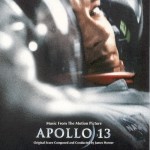
Soundtrack available from MCA
In 1995, I watched as Ron Howard presented us with the story of Apollo 13, scored by James Horner. As a period piece, and an historical one, popular music did take the front seat on this journey. Horner’s score was properly ominous throughout, with heroic beats both for the liftoff and recovery of Apollo 13. While Horner’s music did a decent enough job of maintaining the tension of the film, it doesn’t fare as well without the visuals—this was the first Horner soundtrack I ever bought that I found wasn’t up to the task without the film itself.
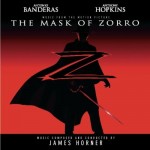
Soundtrack available from Sony
This leads me to the 1998 score for The Mask of Zorro starring Antonio Banderas, Anthony Hopkins and Catherine Zeta Jones. A pretty big Zorro fan before the film, I actually bought the score before the film’s theatrical release! Such was my faith in Mr. Horner and my love of the character. Unfortunately, again the score didn’t fare as well for me without the film. I was expecting more flourishes and more of the “Horner sound” that I had come to love over the years. Apparently in some of the films I had not seen, Mr. Horner had decided to grow a bit and expand his palette. This, of course, is not a crime for a composer. For me, however, it meant that I no longer got to hear the signature sound I had fallen in love with. And so, The Mask of Zorro, while a decent score, fell a bit flat with me.
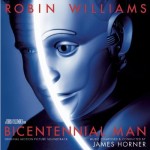
Soundtrack available from Sony
In 1999 Robin Williams starred in the film adaptation of Isaac Asimov’s Bicentennial Man. Horner’s score returned a bit to the fun sound that he had created in Sneakers, adding a distinct piano accompaniment that had been missing in his earlier works. The score is incredibly evocative emotionally as you follow the android Andrew’s journey towards becoming a human being. No individual piece of music stands out in this film more than “The Wedding”. In the film, Andrew (Robin Williams) and his owner Richard Martin (Sam Neill) watch the android’s playback of Martin’s daughter’s wedding from earlier that day. In the film, the look on Martin’s face paints a clear picture of this bittersweet moment of a father watching his daughter, now a woman, leave him to start her own family. Horner’s score gently accompanies this moment with strings playing the grand dance of the wedding, and trailing off to an introspective piece. It’s cinematic music doing exactly what it is supposed to do.
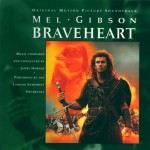
Soundtrack available from Decca
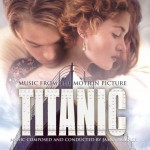
Soundtrack available from Sony
It is unfortunately here that Mr. Horner and I part ways. After the debacles that were Apollo 13 and The Mask of Zorro for me musically, I wouldn’t buy another Horner soundtrack without having seen the film first, and I haven’t seen most of his other films, though there are some big names in there including Titanic, Braveheart, A Beautiful Mind, The Perfect Storm and Jumanji to name a few. And, of course, the next big film to carry the Horner name will be Marvel’s The Amazing Spider-Man. It will be fun to see where he goes with this.
I’ve learned a great many lessons from James Horner. One of these is that it’s perfectly OK for a musician’s works to sound similar—it’s part of their sound. It’s one of the reasons why we go back to listen to them. The Beatles, the Beach Boys, and the Rolling Stones all had their own sounds. So why can’t a film composer?
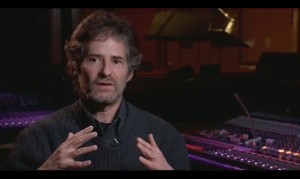
Image courtesy of Paramount Home Entertainment
He also taught me that, like all great artists, composers can also grow beyond their original sounds, and stretch their legs creatively. It’s part of the driving force that pushes all creative people… the ability to grow as an artist. And while I may not always appreciate the way an artist grows, it won’t matter. As long as they have given me the works that I know and love, I know I’ll be all right.
Thank you James Horner for helping me to nurture my appreciation of film music, and for giving me countless hours of laughter and tears listening to your many works.
I watched Cocoon last night on cable…haven’t seen it in probably 20 years. Meanwhile, I’ve been a Star Trek fanatic in that same span. I was in another room when the chase scene came on. Suddenly, the score from STII’s engine room was playing! I actually checked the TV to make sure I wasn’t going nuts. That’s when it dawned on me that Horner did Cocoon! Glad I’m not the only geek that noticed.
They’ve been playing “Cocoon” a lot lately. No matter where I am, I have to stop and watch that part just for that music.
How come Willow didn’t get a mention? It certainly marked the pan-flute debut which has been visited and revisited in movies like Braveheart and Avatar.
“Willow”, unfortunately, didn’t get a mention because this list is a tribute to the works of Mr. Horner through my own experiences. My only memory of “Willow” is going to see it in the theater when I was a child and falling asleep. Perhaps it was over my young head. I have not had the opportunity to see it since. However, Mr. Horner has certainly proven his ability over time to elevate his work above the film which it is scoring, and so I have no doubt that “Willow” is a fine example of his work.